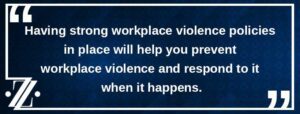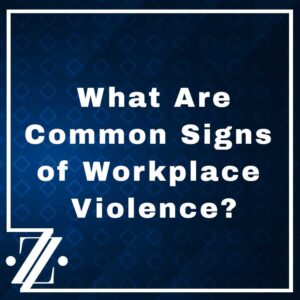Steps To Take if You Experience Workplace Violence
 Workplace violence is a serious and growing concern that can impact anyone, anywhere. Understanding how to recognize, respond to, and prevent workplace violence is crucial for maintaining a safe and productive work environment. Your employer is responsible for preventing workplace violence hazards and giving all employees a safe workplace. But if you do experience it, knowing the steps to take if you experience workplace violence is crucial.
Workplace violence is a serious and growing concern that can impact anyone, anywhere. Understanding how to recognize, respond to, and prevent workplace violence is crucial for maintaining a safe and productive work environment. Your employer is responsible for preventing workplace violence hazards and giving all employees a safe workplace. But if you do experience it, knowing the steps to take if you experience workplace violence is crucial.
At Zentz Law, we are dedicated to empowering you with the knowledge and tools to navigate these challenging situations with confidence and resilience. In this comprehensive guide, we outline the critical steps to take if you experience violence in the workplace, seeing that you are prepared and protected. Contact us today if you’ve experienced workplace violence: 317-220-6156.
Understanding Workplace Violence
Workplace violence encompasses a wide range of worker-on-worker behaviors that can cause physical or psychological harm. It includes physical assault, verbal abuse, bullying, harassment, threats, and intimidation. Recognizing the different forms of workplace violence is the first step toward taking effective action and preventing workplace violence.
Ignoring workplace violence can lead to severe consequences, including physical injury, psychological trauma, and decreased productivity. By addressing these issues promptly and effectively, you not only protect yourself but also contribute to a safer and more supportive workplace culture for everyone.
In this article, we will guide you through what to do if you experience violent behavior or other unacceptable behavior in the workplace. From recognizing early warning signs to reporting incidents and seeking support, this comprehensive guide will equip you with the knowledge and strategies needed to handle such situations with confidence and determination.
Recognizing Workplace Violence: An Employer’s Responsibility
Before employers can address the causes of violence in the workplace, they must understand that this violence can take many forms. There are safety measures that can be taken to protect workers, but only if you understand the types of risks that employees face when violence erupts.
Many workers around the US every year experience attacks from other employees. OSHA states, “Acts of violence and other injuries are currently the third-leading cause of fatal occupational injuries in the United States.” Workplace fatalities are always tragic, but there is something especially horrific about violent acts that cause such deaths.
It is essential to do everything you can to prevent safety issues. You can train employees to recognize signs of workplace violence and report it to appropriate personnel. You can also perform risk assessments to prevent workplace violence. Your workers deserve to be protected.
Types of Workplace Violence
Understanding the various types of workplace violence is crucial in identifying and responding to incidents effectively.
Physical Violence: Physical violence includes any violent incident that involves physical aggression, such as hitting, pushing, or any form of physical assault. These actions can cause significant harm and require immediate intervention. This kind of violence may have criminal intent or erupt unexpectedly.
Verbal Abuse: Verbal abuse involves the use of harsh or threatening language aimed at intimidating or belittling someone. It can include yelling, insults, and other forms of verbally abusive behavior. Workplace violence policies should take verbally abusive employees seriously.
Bullying and Harassment: Bullying and harassment consist of repeated, unwanted actions that create a hostile work environment. This can include spreading rumors, sabotaging work, or persistent intimidation. Even if this harassment doesn’t culminate in a violent act, it must still be addressed.
Threats and Intimidation: Threats and intimidation involve actions or statements intended to cause fear. This can range from direct threats of harm to more subtle forms of intimidation. Local law enforcement will likely need to be involved in this and other forms of workplace violence.
Violence can come from employees, visitors, customers, strangers, and even family members of your employees. Domestic violence can spill over from the home to the workplace when an attacker comes to their victim’s workplace. Some businesses operate in high-crime areas where there is always an additional threat of violence. Always be careful when directing visitors and encourage employees to report suspicious behavior or suspicion of domestic violence from anyone they encounter in the scope of their workday.
Common Signs of Workplace Violence


- Behavioral Changes in Colleagues: Look for sudden changes in behavior, such as increased aggression, withdrawal, or mood swings. These can be early warning signs of potential violence.
- Warning Signs To Look Out For: Other warning signs include frequent conflicts, direct threats or suggestive threatening behavior, or any unusual behavior that raises concerns about a colleague’s well-being.
- Case Studies and Examples: Learning from real-life examples can provide valuable insights into recognizing and addressing workplace violence.
Counseling and Support Services
Employee Assistance Programs (EAP): Many organizations offer Employee Assistance Programs (EAP) that provide counseling and support services. These programs can help your employees cope with the aftermath of workplace violence.
Professional Counseling: Consider offering professional counseling services to victims to help them address any trauma or emotional distress resulting from the incident. Mental health professionals can offer strategies to manage anxiety, stress, and other psychological effects.
How Employers Can Prevent Workplace Violence
Employers have an important role to play when it comes to protecting employees from violence. Preventing workplace violence is just as important as providing an environment that is free of other hazards. Unfortunately, every workplace has the potential to become the site of violence. Even small businesses with a handful of employees should take that risk seriously.
Some of the best ways to accomplish this include:
- Implementing safety policies: Develop and enforce comprehensive workplace violence prevention policies. These policies should outline your pre-employment screening rules, acceptable behavior, reporting procedures, and consequences for violations. You may also launch an employee assistance program to help employees who are facing domestic violence at home.
- Performing regular risk assessments: Look into performing a Workplace Violence Risk Assessment Test (WVRAT) to identify and address risk factors.
- Regular training and drills: Conduct regular training sessions and drills to prepare and train employees for potential violence. Educating employees on how to recognize, respond to, and report workplace violence is essential.
- Establishing a zero-tolerance policy: Adopt a zero-tolerance policy toward workplace violence. Make it clear that any form of violence, including verbal attacks and threats from co-workers, will not be tolerated.
Creating a Supportive Workplace Culture
Employers should set a goal of creating a supportive workplace culture where there is no room for violence. A healthy workplace culture is one where people feel safe, supported, and valued by their co-workers and supervisors alike.
If you focus on these steps, you can improve the culture at your workplace, which should assist in your workplace violence prevention goals.
- Encourage open communication: Foster an environment where employees feel comfortable discussing safety concerns and reporting incidents. Open communication can help identify and address issues before they escalate.
- Build strong team relationships: Promote teamwork and mutual respect among employees. A strong personal relationship can reduce the risk of conflicts and contribute to a supportive workplace.
- Promote mental health and well-being: Prioritize mental health and well-being in the workplace. Provide your employees with resources and support for their mental health as this can help prevent workplace violence and create a healthier work environment.
Workplace violence is a serious issue that requires immediate and decisive action. By recognizing the signs, knowing the steps to take during an incident, and understanding workplace violence prevention, you can contribute to a safer and more supportive workplace.
Immediate Steps for Workplace Violence Victims to Take During an Incident
Your safety is paramount. If you have experienced violent incidents in the workplace or are concerned about the possibility of someone becoming violent, here are the immediate steps to take in the aftermath of workplace violence.
Evacuate the Area: If you are in immediate danger, evacuate the area as quickly and safely as possible. Do not hesitate to leave the scene to protect your own safety. The more space that you can put between yourself and a violent individual, the better!
Find a Safe Space: If evacuation is not possible, find a safe space where you can protect yourself from harm. Lock doors, hide, or use any available means to create a barrier between yourself and the aggressor.
Call for Help: Contact emergency services or law enforcement personnel immediately. Providing them with accurate and detailed information about the incident can expedite their response and protect your safety.
The Importance of Taking Personal Safety Measures
Although it would be wonderful to trust that every employer will make the right decisions when it comes to workplace violence prevention, the fact is that employees may need to take action and think on their feet in a crisis.
We recommend the following:
Being Aware of Your Environment: Stay alert and aware of your surroundings. Recognizing potential risks and early warning signs can help you take protective measures to protect your safety.
Communication Strategies: Effective communication can defuse potentially violent situations. Learning conflict resolution and de-escalation techniques can be invaluable in preventing violence.
Self-Defense Training: Consider undergoing self-defense training. Knowing how to protect yourself physically can provide confidence and safety in dangerous situations.
When To Contact Authorities
Calling 911 or Emergency Services
Dial 911 or your local emergency number to report the incident, even if it has ended. Provide as much information as possible, including your location, the nature of the violence, and any immediate threats you received.
Notifying Security or Management
Inform your workplace security team or management about the incident. They can take additional steps to protect your safety and address the situation appropriately. They can also take preventive measures to make sure that you and your co-workers are safe from the further risk of violence at work.
Providing Immediate Support to Other Victims
First Aid Measures: If you or anyone else has sustained injuries, administer first aid if you are able. See that medical attention is sought immediately for any serious injuries.
Supporting Colleagues Involved: If colleagues are also affected, offer your support and assistance. Working together can help manage the immediate aftermath of a violent incident and protects everyone’s safety.
Reporting the Incident
Reporting workplace violence is critical for legal and organizational reasons. It helps prevent future incidents and sees that appropriate actions are taken. It also creates an essential paper trail for any future legal claims you need to make.
An employer who fails to take appropriate security measures or properly address a violent event may be held liable for negligence. Most of the time, employees can’t sue their employers for workplace injuries, because worker’s compensation covers on-the-job injuries and occupational health concerns.
However, employees may be able to hold their employers responsible for failing to appropriately prevent a co-worker from attacking them. Even if you are not required to report the incident to your employer, doing so after an incident occurs can help you and other affected workers get justice.
What Are My Legal Actions and Rights After a Violent Incident at Work?


If your employer failed to take reasonable action to protect you and your co-workers from harm, you may be able to file a claim against them.
- File a complaint: Filing a formal complaint with your organization or relevant authorities can initiate an investigation and hold perpetrators accountable.
- Understand your employee rights: Familiarize yourself with your rights as an employee. Knowing your legal protections can empower you to take appropriate actions and seek justice.
- Seek legal advice: Consulting with a legal professional can provide guidance on your options and help you navigate the legal complexities of workplace violence incidents.
How To Report Workplace Violence
Internal Reporting Procedures
Follow your organization’s internal reporting guidelines. This typically involves notifying your immediate supervisor, HR, or the designated safety officer.
External Reporting Options
In cases of severe violence, contacting law enforcement is essential. They can provide immediate protection and initiate a criminal investigation if necessary.
Occupational Safety and Health Administration (OSHA): OSHA provides guidelines and support for workplace safety. Reporting to OSHA can help address systemic issues and seek compliance with safety regulations.
Human Resources (HR) Departments: HR departments play a crucial role in handling workplace violence incidents. They can provide support, investigate the incident, and implement necessary measures to prevent future occurrences. They may also connect you with an employee assistance program that is used in circumstances like these.
Documenting the Incident
You will need to provide an account of what happened. This means documenting the incident for your lawyer and/or the courts. If your employer failed at workplace violence prevention, you may be entitled to compensation for your injuries.
Similarly, family members of victims killed in workplace fatalities may be eligible to file a wrongful death lawsuit.
Collect Evidence
Gathering evidence is crucial for any investigation. Take photos, videos, and collect witness statements to support your report.
Write a Detailed Report
Create a detailed report of the incident, including the timeline, description of events, and the parties involved. Accurate documentation can aid in any subsequent investigations and legal proceedings.
Contact Zentz Law for Legal Assistance


At Zentz Law, we are providing resources to survivors of workplace violence. Share this article to spread awareness and encourage others to take action against workplace violence. Call our firm today at 317-220-6056.
We believe that you are strong enough to get through this difficult time. Remember, your safety is non-negotiable, and taking proactive measures can make a significant difference. Stay informed, stay safe, and let’s work together to create a violence-free workplace.

